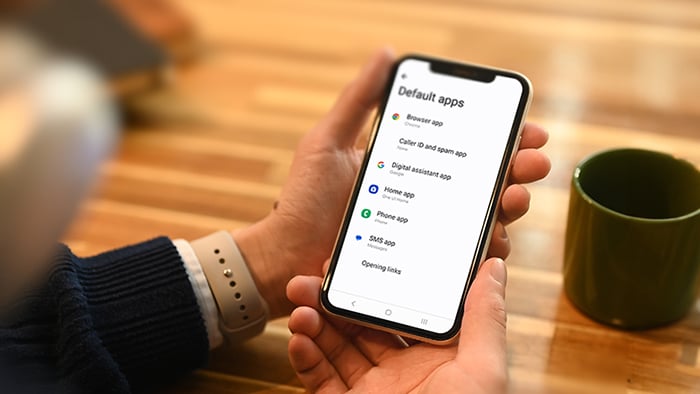What is “Do Not Track”?
Do Not Track is a web browser setting that adds a signal to your browser’s header, telling other websites that you don’t want their tracking cookies. By 2011, DNT had been adopted by all the major browsers, but it’s not enforceable and many websites have refused to honor it.
Generally, the more companies and websites know about you, the more refined and targeted their content and sales pitches will be. So they do what they can to keep track of your activities on their site.
Cookies are one of the most popular tools websites use to collect data on their visitors. Cookies are small pieces of data stored as text files in your browser. The data that cookies gather can include what you clicked on, what you purchased, where you are, and more. Other methods of tracking your online activities include browser fingerprinting and social media scraping.
While web tracking isn’t necessarily malicious, you may not want companies following everything you do online. Unfortunately, DNT is not an effective way to prevent online tracking, because DNT doesn’t carry legal weight and was never widely adopted. But you can still use DNT alongside more effective anti-tracking techniques like hiding your IP address, browsing privately, setting up a VPN, and other methods.
If you’re concerned about online tracking, you’ll definitely want to keep reading for our advice on additional privacy tools later on in this article.
How does DNT work?
DNT works by telling websites you don’t want their cookies. When you send or receive data from your computer, that request opens with a “header.” Headers contain data like the type of web browser you’re using. When DNT is enabled, it adds a Do Not Track request to the header.
Because DNT is part of your header, rather than being stored as a cookie, it is not cleared when you delete your cookies. So once you enable DNT, it remains on.
But the Do Not Track request is just that — a request. Websites can choose to honor the request or not, and unfortunately most of them don’t.
While DNT was once supported by all the major browsers, it was removed from Apple’s Safari browser in early 2019. But Google Chrome, Mozilla Firefox, and Microsoft Edge still support DNT.
But DNT on its own is not effective enough to protect your privacy. Thankfully, dedicated private browsers are a lot more effective at stopping tracking than DNT. With a secure and private browser, you can actually block tracking, rather than simply requesting it and hoping companies and advertisers comply.
Avast Secure Browser features built-in anti-tracking and anti-fingerprinting technology. It forces websites to use encryption to keep your data secure and comes with an automatic ad blocker.
Is “Do Not Track” effective?
No, Do Not Track is not very effective. Without legislation or some sort of meaningful arrangement behind it, Do Not Track has no teeth. Even if all the browsers made it possible to include a Do Not Track option, that doesn’t mean that companies that want to track you will comply.
As it stands, there is no legal requirement for companies to comply with your Do Not Track request in the US, the EU, or anywhere else — and this is unlikely to change anytime soon. DNT was a great idea that never progressed beyond the “request” stage. Sending a DNT request is a bit like telling your grandmother, “I don’t want any more cookies.” You’re still going to get more cookies.
And asking your browser to send a DNT request is especially ineffective when you’re signed into a particular service, like Google or Facebook. While you’re logged in, it’s just too easy for these services to track what you’re doing on their platforms and wherever else you visit in the same web session. That’s how Google gets so much data on their customers.
What happened to DNT?
When DNT was first implemented, you had to enable the setting in your browser to use it. That meant that if someone didn’t know about web tracking or didn’t care, they would still be tracked by default. In 2012, Microsoft flipped how DNT was set up by turning on the Do Not Track option by default.
That decision spurred advertisers and other companies to form the Tracking Protection Working group alongside ad delivery platforms and ad industry trade groups. Together, they managed to sabotage the DNT efforts. And just like that, DNT’s potential was stymied before it even had a chance to gain the support it needed. While Microsoft eventually walked this decision back in 2015, the damage it had done, and DNT was left as more of an idea than a solution.
Which browser does not track you at all?
Using one of the best private browsers is a more effective way to protect your privacy than using the Do Not Track setting in a standard browser. A browser built specifically for security and privacy, like Avast Secure Browser, has much stronger privacy protections than simply using a private window in incognito mode — which wipes your session data from your device but doesn’t prevent advertisers from tracking you.
If you don’t want to change your default browser, though, you should use anti-tracking software like Avast AntiTrack. This software will alert you to tracking attempts, tell you who’s trying to track you, and protect your digital profile from being used by data brokers.
Do Not Track on its own is not enough to protect your privacy. And while dedicated ad-blockers can stop you from seeing ads, that doesn’t mean advertisers can’t see what you’re doing. Get Avast AntiTrack today to block advertisers and companies from following you around the web and collecting data about your behavior and preferences.
How to change your browser DNT settings
Changing your DNT settings is pretty similar across browsers, but there are some small differences. Here’s how to change your DNT settings on the four most popular browsers: Chrome, Firefox, Safari, and Edge.
Enable DNT in Chrome
Blocking websites from tracking you in Chrome used to require an extension, but now the option is included by default. You can also switch to incognito mode in Chrome. Here’s how to turn on DNT in Chrome:
-
Click the Chrome menu in the upper-left corner of your screen and select Preferences. (If you don’t see the menu, click the three vertical dots in the upper right of your browser window and select Settings.)
%20and%20does%20it%20work%20(Academy)/img_01.png?width=300&name=img_01.png)
-
Look for Settings on the left and select Privacy and Security.
%20and%20does%20it%20work%20(Academy)/img_02.png?width=350&name=img_02.png)
-
In the center of your screen, click Cookies and other site data.
%20and%20does%20it%20work%20(Academy)/img_03.png?width=978&name=img_03.png)
-
To turn off tracking in Chrome, toggle the setting off for Send a “Do Not Track” request with your browsing traffic.
%20and%20does%20it%20work%20(Academy)/img_04.png?width=692&name=img_04.png)
Enable DNT in Firefox
While not a private browser by default, private browsing in Firefox is still an option, along with other ways to disable search tracking. Here’s how to turn on Do Not Track requests in Firefox:
-
Click the Firefox menu and select Preferences. (If you don’t see the menu, click the three horizontal lines known as the hamburger menu in the upper right of your browser window and select Options.)
%20and%20does%20it%20work%20(Academy)/img_05.png?width=250&name=img_05.png)
-
On the left of the screen, select Privacy & Security.
%20and%20does%20it%20work%20(Academy)/img_06.png?width=500&name=img_06.png)
-
Underneath the Standard protection section (or the Browser Privacy section), you’ll see a header that says Send websites a “Do Not Track” signal that you don’t want to be tracked. Select the Always option.
%20and%20does%20it%20work%20(Academy)/img_07.png?width=1048&name=img_07.png)
Enable DNT in Safari
The Safari browser no longer supports Do Not Track, but you can use Safari’s incognito mode to open a private window. Or, you can block all cookies with a browser setting. Here’s how to block all cookies in Safari:
-
Click the Safari menu in the upper left corner of your screen, and select Preferences.
%20and%20does%20it%20work%20(Academy)/img_08.png?width=300&name=img_08.png)
-
Select the Privacy tab in the top navigation menu.
%20and%20does%20it%20work%20(Academy)/img_09.png?width=823&name=img_09.png)
-
Check the Block all cookies box.
%20and%20does%20it%20work%20(Academy)/img_10.png?width=1180&name=img_10.png)
Note that you may need cookies enabled to make some websites, or some functionality, work properly. This is particularly helpful if you’re shopping online and want to store items in a shopping cart.
Enable DNT in Edge
Here’s how to turn on DNT in Microsoft’s Edge browser:
-
Click the Edge menu and select Preferences. (If you don’t see the menu, click the three horizontal dots in the upper right of your browser window and select Settings.)
%20and%20does%20it%20work%20(Academy)/img_11.png?width=300&name=img_11.png)
-
Under Settings on the left of your screen, click the Privacy, Search, and Services tab.
%20and%20does%20it%20work%20(Academy)/img_12.png?width=400&name=img_12.png)
-
Toggle on the Send “Do Not Track” Requests option.
%20and%20does%20it%20work%20(Academy)/img_13.png?width=829&name=img_13.png)
What are the alternatives?
As mentioned above, DNT is pretty much completely ineffective. So, if you really want to block tracking, here are some other, better ways to protect your online privacy:
DNT may not have been successful, but the methods listed above provide an even greater line of defense against intrusive online tracking.
Block tracking and browse privately with Avast Secure Browser
There are myriad ways you can be identified online, and advertisers and data miners are constantly innovating. But you don’t have to let your online traffic be an open book. Turn the page on trackers by downloading free Avast Secure Browser.
Conceal your digital identity, prevent third parties from tracking you, and get alerts if any of your passwords leak. Plus, with the built-in and super secure Bank Mode feature, you can access your financial information without worrying about anyone peeking in.
%20and%20does%20it%20work%20(Academy)/What-is-Do-Not-Track-DNT-Hero.jpg?width=1200&name=What-is-Do-Not-Track-DNT-Hero.jpg)
%20and%20does%20it%20work%20(Academy)/img_01.png?width=300&name=img_01.png)
%20and%20does%20it%20work%20(Academy)/img_02.png?width=350&name=img_02.png)
%20and%20does%20it%20work%20(Academy)/img_03.png?width=978&name=img_03.png)
%20and%20does%20it%20work%20(Academy)/img_04.png?width=692&name=img_04.png)
%20and%20does%20it%20work%20(Academy)/img_05.png?width=250&name=img_05.png)
%20and%20does%20it%20work%20(Academy)/img_06.png?width=500&name=img_06.png)
%20and%20does%20it%20work%20(Academy)/img_07.png?width=1048&name=img_07.png)
%20and%20does%20it%20work%20(Academy)/img_08.png?width=300&name=img_08.png)
%20and%20does%20it%20work%20(Academy)/img_09.png?width=823&name=img_09.png)
%20and%20does%20it%20work%20(Academy)/img_10.png?width=1180&name=img_10.png)
%20and%20does%20it%20work%20(Academy)/img_11.png?width=300&name=img_11.png)
%20and%20does%20it%20work%20(Academy)/img_12.png?width=400&name=img_12.png)
%20and%20does%20it%20work%20(Academy)/img_13.png?width=829&name=img_13.png)











